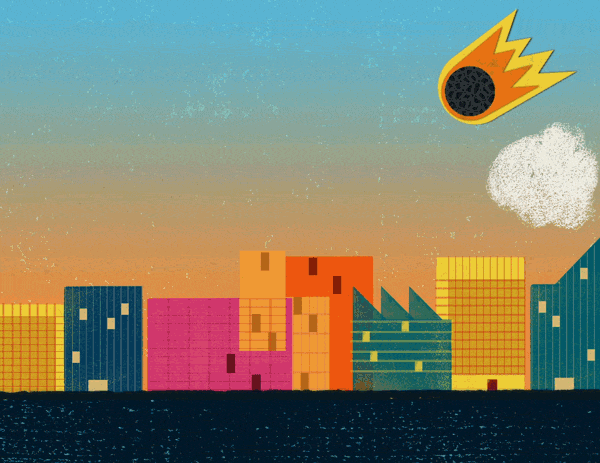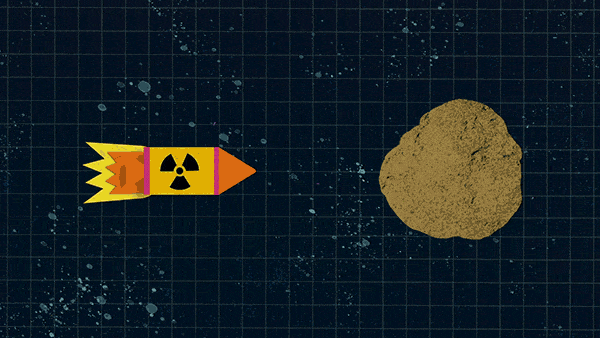
In the 1998 movie, “Armageddon,” an asteroid the width of Texas is about to hit Earth. The heroes who stop it in just the nick of time are a group of orange-suited Americans, all men.
Life isn’t always like the movies.
Not that an asteroid couldn’t slam into Earth, mind you. Asteroids — mostly tiny ones — pass by our planet virtually every second. But the people charged with stopping the big ones aren’t reaching for their spacesuits with mere hours to spare.
And spoiler alert: They also aren’t all men.

“I would say the number one question I get when I tell people what I work on, is ‘Oh, like ‘Armageddon?’’ And it’s nothing like ‘Armageddon,’” says Lawrence Livermore National Lab physicist Kirsten Howley, whose day job includes defending our planet from asteroids.
Howley doesn’t have an orange jumpsuit at hand, but her job is serious business. She and her team of planetary defenders specialize in how we might deflect an asteroid that poses a threat to Earth. Like Bennu.
Bennu, weighing more than 78 billion kilograms, is an ancient asteroid currently orbiting the sun on a path that brings it close to Earth. It has a 1-in-2,700 chance of colliding, albeit not until 2185.
Last fall, NASA collected a sample from Bennu, the first NASA mission to procure material from an asteroid as it traveled through space. Those samples, once they make it back to Earth, will help physicists like Howley with their very important job — to make sure Bennu (and objects like it) don’t impact.
What that effort requires is a lot more complicated, and less immediately perilous, than the movies would have you think, although the goal of saving life on Earth is just the same.
For starters, Bennu is far more compelling than some dumb rock. What we’ve already learned, and hope to learn about it, could not only save the planet — it could also help change our understanding of what an asteroid (or even life) is.
Bennu
Before you think of Bennu simply as a missile hurtling through space, consider it as an object of interest in its own right.
Bennu is much older than Earth. Discovered in 1999, it’s roughly 4.5 billion years old and is believed to have formed 10 million years before our own solar system. That makes Bennu of extraordinary interest to scientists who want to piece together how our world came to be.
Little NASA spacecraft OSIRIS-REx (or Origins, Spectral Interpretation, Resource Identification, Security-Regolith Explorer) collected a sample from the asteroid in October 2020, and will return within three years with its precious cargo. Scientists hope these small fragments from Bennu will shed light on the origins of life on Earth; indicate whether we could mine asteroids for rare elements; and signal whether Bennu contains water.
If asteroids do have water, the possibility of humans living far from planet Earth becomes much easier to imagine. Photos from the NASA spacecraft also captured images of particles flying off Bennu a few times a week — making it what they call an active asteroid, a rare classification.
In short, Bennu will help us learn a lot more about asteroids, and possibly ourselves. Of course, it’s also as tall as the Empire State building, and possesses an orbit that could get a little too close for comfort.
Study it while we can, but if it gets too close, what will we do? That’s where Howley comes in.
Planetary defenders
If this were a movie, Howley and her team would be on the poster, among the people tasked with saving the Earth. But Oakland native Howley, who chased her childhood passion for the stars from community college to UC Berkeley to UC Santa Cruz, where she became the first person in her family to earn a Ph.D., is not sitting around waiting to jump onto a rocket at a second’s notice.
Because she doesn’t have to. Her arsenal against Earth-killing asteroids includes physics and math.
“NASA was tasked with finding all of the asteroids that were a kilometer size and larger and they have found more than 90 percent of those objects that come close to Earth’s orbit, any of them that might be a near-Earth object or potentially hazardous,” Howley says. Howley considers “close” to Earth as less than a hundred million miles. Any asteroid that is coming within that distance and is a football field-and-a-half in size, or larger, is potentially hazardous.
You can exhale knowing that there aren’t any asteroids coming near Earth that fit Howley’s criteria in this century — not even Bennu. If it does hit Earth, it won’t strike until 2175 at the earliest. But that doesn’t mean Howley and her team aren’t constantly preparing and improving our asteroid response.
The important thing to remember is that the asteroids you see in movies are just that — fictional.
Unlike Bruce Willis, who is chasing after a Texas-sized (800-mile-wide) asteroid, Howley is far more concerned with smaller objects — asteroids that are harder to track and find and which won’t take out the entire world, but could still do major damage.
These are asteroids that can damage a city or a small state and because they are smaller, they are harder to see. None of these are currently threatening Earth.
“There aren’t any asteroids right now that we are concerned about,” Howley says.
Asteroids like Bennu allow Howley to collect data about their orbits, so they can extrapolate for future asteroids and develop mitigation strategies that could prevent a hurtful impact. And they help teams like hers to evaluate newly discovered asteroids.
Avengers, assemble
One thing that is like the movies is that preventing a major asteroid from hitting Earth is a team effort. Lawrence Livermore National Laboratory specializes in deflection and mitigation strategies. NASA thinks about spotting all the asteroids in the great beyond and how to get to them if they have to do so. Their teams, and teams from all over the world, meet together annually to discuss and simulate asteroid management strategies. Their thinking is very, very long term.
Bennu, for example, has a 1-in-2,700 chance of hitting Earth in 2185.

“That sounds scary!” Howley says. “However, that probability is going to evolve. 1-in-2700 is because we don’t really know with enough accuracy what its orbit is going to be in 2135.”
2135 contains what is known in astronomy as a keyhole, a moment when the orbit of an object can drastically shift — to or away from Earth.
“When we know that better, the odds will change.” (A collision will become less likely, Howley suspects).
“We have a mitigation strategy for Bennu,” Howley adds, and we have already demonstrated our capacity to learn more about it — to send up our OSIRIS-REx spacecraft, for example.
The amount of data we have about Bennu, and our ability to forecast where it will be more than 100 years from now, makes it easy for Howley to sleep at night. As does the ongoing, international work to manage and plan for the threat of other asteroids.
“I worry more about wearing sunscreen,” says Howley.
That really means something when you understand just how catastrophic it would be should an asteroid like Bennu hit Earth.
“If Bennu were to impact Earth today it would release about 2.7 gigatons of energy — that’s more than a million Hiroshima-type bombs and nobody wants that kind of impact,” Howley says.
But we have studied Bennu’s orbit well enough to know this is not a threat in the near future.
And thanks to NASA’s little OSIRIS-REx spacecraft — the Bruce Willis of this film — we will soon know more about Bennu’s composition and mass. That kind of information is really important to developing mitigation strategies, so we can understand how the asteroid would react if, say, we decided our only chance to save Earth was to bomb an asteroid into oblivion.
Explosions in deep space
So what about the explosions? What about the last-minute heroics?
In “Armageddon,” Dolly, the aforementioned asteroid the size of Texas (“we do not know of any asteroid the size of Texas,” Howley notes), was just an hour from hitting Earth when the movie’s heroes scrambled to stop it.
“So, we’re talking about something that’s an 800-mile-in-diameter object that’s going to hit Earth in one hour. The amount of energy it would take to push two equal-sized pieces in opposite directions such that they miss Earth [like in “Armageddon”] is equivalent to about the total energy output of the sun in a day,” Howley says. “And we do not have that capability.”
Fortunately, we don’t need that capability if we can see them coming earlier. The variety of strategies Howley and teams like hers deploy are designed to avoid asteroid-vs.-man showdowns.

Using an explosion to redirect an asteroid — like in “Armageddon,” — is actually possible, Howley says: “A nuclear device is not out of the question, it actually is a very efficient approach in terms of depositing energy into a body to give it a push.” A push away from Earth.
One option Howley is working on to deliver such a push is called HAMMER or Hypervelocity Asteroid Mitigation Mission for Emergency Response.
The hammer, in this case, would be a small spacecraft carrying a nuclear device that would explode on or near the asteroid. This is much different than an explosion on Earth — all that nuclear energy would go right into the asteroid, rocketing the asteroid away. That little spacecraft, should it ever be sent upon such a mission to Bennu, would benefit from the work of its predecessor, the present-day OSIRIS-REx spacecraft, as we would need to know the composition of an asteroid before attempting such a strategy.
“We don’t want to deposit a bunch of energy and break up the asteroid in an unpredictable way, we want to make sure we know we’re in control of what’s going on,” Howley says.
The 1998 movie “Deep Impact” portrays just such a scenario, in which an attack on a comet causes it to break into two pieces, still dangerous.
Howley and other planetary defenders have figured out that we can avoid this problem by using some kind of kinetic impactor — for example, a spacecraft, sans nuclear weapon, that simply rams into the asteroid, and nudges it off course.
The kinetic impactor option also steers clear of the admittedly tough politics that could surround any use of a nuclear weapon for planetary defense. But it’s something that Howley and other international teams think about how to navigate.
“Although I can assure you it’s safe, there’s still a perception it is not,” she says. Fortunately, constant international cooperation has laid the groundwork for diplomacy. Teams around the world meet and simulate how they would respond to threats from both a scientific and political point of view. How would you deal with a skeptical world leader? How would you communicate to a worried public? They run through all of these scenarios, and more.
“I just think it’s good to have a plan,” Howley says.
Of course you can’t always plan for every eventuality. Some smaller asteroids are hard to spot — like the 2020 QG asteroid that passed within 10,000 miles of Earth from the direction of the sun (and probably would have burned up in our atmosphere had it come too close).
Or the Chelyabinsk asteroid in 2013 that exploded in the sky over Russia, causing a blast wave that injured 1,500 people.
NASA is working on a program to improve our capabilities for spotting the harder-to-see ones, which nonetheless have an extremely low probability of causing catastrophic damage on Earth. There are a lot of objects moving around in space — from shooting stars, satellites and space debris. Of course, the consequences of the low-probability events Howley plans for could be very destructive.
“I’m constantly reassuring my friends and family like, ‘Oh, there’s another one I didn’t even know about.’ I think it’s good to know that these things are flying by all the time, we’ve seen a lot of them. Sometimes we don’t discover them until they are close to Earth passing by. That is quite common just because they’re dim and they’re hard-to-see. So it’s always good to keep perspective.”
“But just because something is coming close to Earth doesn’t mean that it’s a risk.”
There are other benefits to Howley and her team’s work, beyond preparing for scenarios that hopefully never come to pass. Their studies can help advance our understanding of things that are larger than just asteroids, like how life got started on Earth.
“All this information is useful just for science in general, for other ideas that we haven’t even thought of that might be outside the box, things that people want to do.”
Asteroids could one day be a stepping stone for humanity to life on other planets, for example. The idea of mining asteroids for essential elements is another possibility that could come to pass because of the work being done today.
“Scientists of the present day always benefit from the science that was done before them,” Howley says. “All of this will benefit the next generation.”
So, while Howley may get texts from time to time from friends and family worried about the latest asteroid to make headlines, it’s important to remember, there’s no need to sensationalize. The sky is vast and fascinating. Step outside and enjoy it — but don’t lose any sleep over it. Save the scary stuff for the movies.
Courtesy: University of California
https://ift.tt/o7id3Ys
https://ift.tt/8LtvPwh





0 Comments